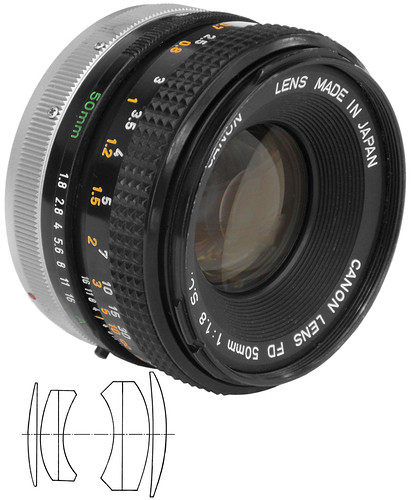Difference between revisions of "Double Gauss"
(skimpy start but may expand) |
(have an okay illustration, may keep looking) |
||
| Line 1: | Line 1: | ||
| − | {{ | + | {{Flickr_image |
| − | The cornerstone of "normal" lens designs in the f/1.7-f/2.0 class, the '''double Gauss''' formula originates with | + | |image_source= https://www.flickr.com/photos/alf_sigaro/29303737971/in/pool-camerawiki/ |
| + | |image= https://live.staticflickr.com/8220/29303737971_8a18df3ff5.jpg | ||
| + | |image_align= right | ||
| + | |image_text= Deeply-curved doublets bracketing<br>the iris are a double-Gauss hallmark.<br>Improved double-Gauss designs<br>introduce some mild asymmetry | ||
| + | |image_by= Alf Sigaro | ||
| + | |image_rights= nc | ||
| + | }} | ||
| + | The cornerstone of "normal" lens designs in the f/1.7-f/2.0 class, the '''double Gauss''' formula originates with the [[Carl Zeiss | Zeiss]] [[Planar]] of 1896. The classical version has six elements in a 1-2-2-1 configuration, symmetrical around the aperture stop. | ||
| − | Photographers may simply refer to a "Gauss" design lens. Strictly this is not correct, as Carl Friedrich Gauss had originally described a | + | Photographers may simply refer to a "Gauss" design lens. Strictly this is not correct, as Carl Friedrich Gauss had originally described a telescopic objective pairing a positive and a negative element. Using two Gaussian lenses back-to-back was the vital innovation for photography. |
| − | Countless derivatives of this formula have been manufactured with variations including air-spacing rather than cementing the inner doublets; splitting the outer elements into two, | + | Countless derivatives of this formula have been manufactured with variations including air-spacing rather than cementing the inner doublets; splitting the outer elements into two, and so on. Lenses in the f/1.0–f/1.4 class are frequently these modified double-Gauss designs. |
Revision as of 19:13, 12 November 2022

|
| Deeply-curved doublets bracketing the iris are a double-Gauss hallmark. Improved double-Gauss designs introduce some mild asymmetry image by Alf Sigaro (Image rights) |
The cornerstone of "normal" lens designs in the f/1.7-f/2.0 class, the double Gauss formula originates with the Zeiss Planar of 1896. The classical version has six elements in a 1-2-2-1 configuration, symmetrical around the aperture stop.
Photographers may simply refer to a "Gauss" design lens. Strictly this is not correct, as Carl Friedrich Gauss had originally described a telescopic objective pairing a positive and a negative element. Using two Gaussian lenses back-to-back was the vital innovation for photography.
Countless derivatives of this formula have been manufactured with variations including air-spacing rather than cementing the inner doublets; splitting the outer elements into two, and so on. Lenses in the f/1.0–f/1.4 class are frequently these modified double-Gauss designs.